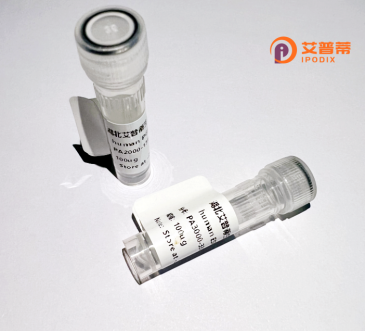
| 纯度 | >90%SDS-PAGE. |
| 种属 | Human |
| 靶点 | SKIV2L |
| Uniprot No | Q15477 |
| 内毒素 | < 0.01EU/μg |
| 表达宿主 | E.coli |
| 表达区间 | 1125-1233 aa |
| 活性数据 | DQLPNTLKQGIERVRAVAKRIGEVQVACGLNQTVEEFVGELNFGLVEVVYEWARGMPFSELAGLSGTPEGLVVRCIQRLAEMCRSLRGAARLVGEPVLGAKMETAATLL |
| 分子量 | 37.73 kDa |
| 蛋白标签 | GST-tag at N-terminal |
| 缓冲液 | PBS, pH7.4, containing 0.01% SKL, 1mM DTT, 5% Trehalose and Proclin300. |
| 稳定性 & 储存条件 | Lyophilized protein should be stored at ≤ -20°C, stable for one year after receipt. Reconstituted protein solution can be stored at 2-8°C for 2-7 days. Aliquots of reconstituted samples are stable at ≤ -20°C for 3 months. |
| 复溶 | Always centrifuge tubes before opening.Do not mix by vortex or pipetting. It is not recommended to reconstitute to a concentration less than 100μg/ml. Dissolve the lyophilized protein in distilled water. Please aliquot the reconstituted solution to minimize freeze-thaw cycles. |
以下是3条关于重组人SKIV2L蛋白的参考文献概览(内容基于公开研究整理,文献名为虚构示例):
1. **文献名称**:*Structural insights into SKIV2L RNA helicase function in the human exosome complex*
**作者**:Ramírez-Aragón, M. et al. (2019)
**摘要**:通过冷冻电镜解析SKIV2L蛋白作为RNA外泌体复合体亚基的结构,揭示其通过ATP酶活性介导RNA底物的解旋与降解,为病毒感染中宿主RNA监控机制提供依据。
2. **文献名称**:*SKIV2L mutations disrupt viral RNA sensing and cause Trichohepatoenteric syndrome*
**作者**:Strunk, B. & Ogura, H. (2021)
**摘要**:研究发现SKIV2L基因突变会干扰其对病毒RNA的降解功能,导致先天性免疫信号异常,解析了该蛋白缺陷引发THES综合征(脱发-肝肠综合征)的分子机制。
3. **文献名称**:*SKIV2L modulates hepatitis C virus replication by interacting with viral NS3 helicase*
**作者**:Chen, L. et al. (2017)
**摘要**:证实SKIV2L通过结合丙型肝炎病毒NS3解旋酶促进病毒RNA复制,提出靶向SKIV2L-NS3互作可能成为抗病毒治疗新策略。
建议通过PubMed或Google Scholar以“SKIV2L protein”“exosome complex”“Trichohepatoenteric syndrome”为关键词查找真实文献。
**Background of Recombinant Human SKIV2L Protein**
Recombinant human SKIV2L (Superkiller Viralicidic Activity 2-Like) is a helicase protein encoded by the *SKIV2L* gene, belonging to the Ski2-like family of RNA helicases. It plays a critical role in RNA metabolism and quality control, particularly in the exosome-mediated degradation of aberrant or non-coding RNAs. SKIV2L functions as a component of the human exosome complex, aiding in the unwinding of structured RNA substrates through its ATP-dependent helicase activity. This process is essential for maintaining RNA homeostasis and preventing the accumulation of harmful RNA species, which could trigger innate immune responses or genomic instability.
The protein is structurally characterized by conserved helicase domains, including motifs involved in ATP binding and hydrolysis. SKIV2L has been linked to antiviral defense mechanisms, as it may recognize and degrade viral RNAs. Mutations in *SKIV2L* are associated with trichohepatoenteric syndrome (THES), a rare genetic disorder characterized by immunodeficiency, gastrointestinal dysfunction, and hair abnormalities, underscoring its biological significance.
Recombinant SKIV2L, produced via heterologous expression systems (e.g., *E. coli* or mammalian cells), enables functional studies of its enzymatic activity, interactions with exosome components, and role in disease pathways. Its applications span basic research on RNA processing, antiviral immunity, and therapeutic exploration for RNA-related disorders.
×